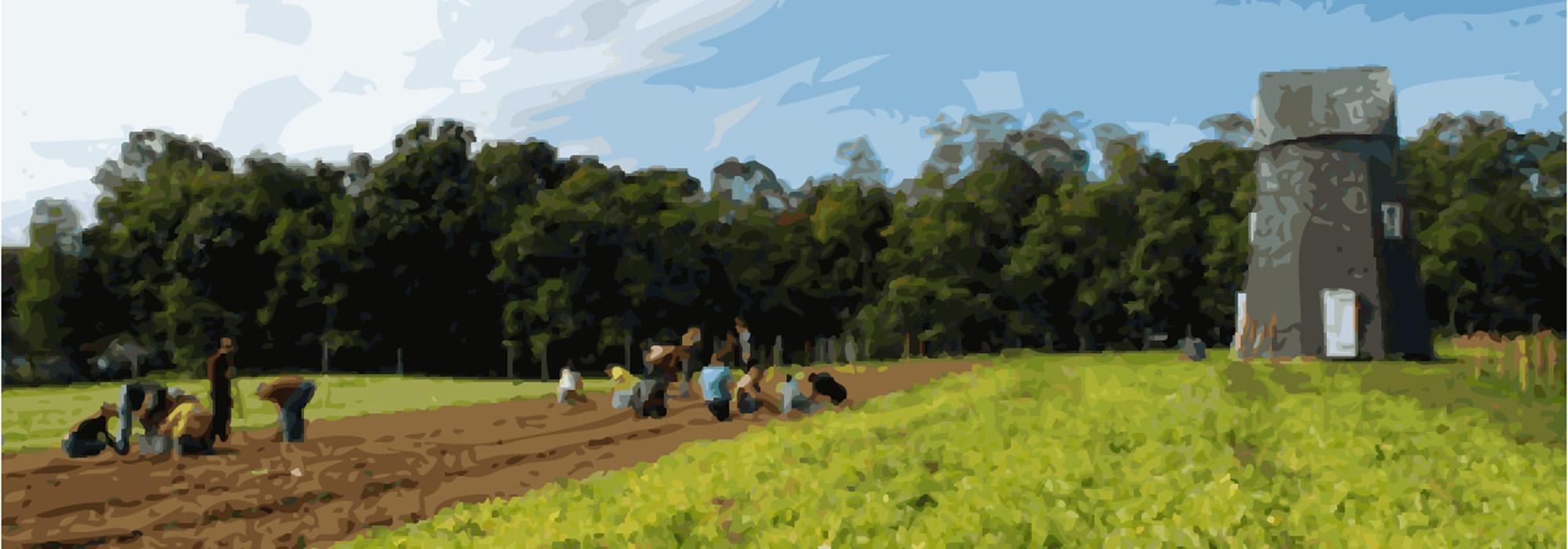It Takes One: Bennett Konesni
I was born in Asheville, North Carolina, raised in coastal Maine and now living on Shelter Island, New York, I have been surrounded by powerful, iconic landscapes for most of my life.
My home is Sylvester Manor, a former plantation/estate that has been in my family since 1651. Along with 243 acres of fields and forests, the Manor still holds the remains of an 18th century garden, an iconic wind-powered gristmill, and an early Georgian manor house. My job is to bring this historic gem into a new era, which preserves and interprets the past while engaging its stories to grow a culture of food and place, in a way that is delicious, joyful and fair.
I am an organic farmer and a musician. A lover of old songs, I can be found out hollering in the garden with my crew. We’ve got a small farm here and we sing work songs together: farmer’s laments, sea shanties, rounds - you name it. Out in the fields we’re preserving and growing a cultural landscape every day.
How would you define a cultural landscape?
It’s like a quilt. A cultural landscape is a patchwork of human fellowship with the land: a dynamic cloth of many colors, traditions, organisms and designs, which grabs you with its beauty and authenticity.
Why did you get involved in the landscape that was threatened in your community?
At first it was out of curiosity for my family and our place, to discover who we are and to learn how did we got this way. I joined an archaeological dig on the property, and then worked on local farms during a summer break from Middlebury College.
After college it became clear that I could make a difference here. I saw what the Manor and its 243 acres might become, either chopped up, developed and sold off or restored as a living reminder of where we’ve been and where we’re going. The difference was too big to ignore, so, with the blessings of my family, I moved in and got started.
How did your understanding of this landscape change as a result of your advocacy efforts?
I learned that the narrative of manifest destiny, of pioneer settlers hacking homesteads out of the woods to feed their families, is not the only American landscape story. In fact, at Sylvester Manor I learned that we have five stories, five eras of land and culture. The first cultural landscape here was the Native Americans who hunted, fished and grew crops, changing the land with fire, arts, and a deep knowledge of place.
The second era began in 1651, when the Sylvester’s multinational food corporation started a plantation that shipped food to all corners of the Atlantic world. Africans, Native Americans and Europeans lived here together- in freedom and in bondage- creating a landscape that was filled with diverse ideas, customs, and plants.
Beginning roughly in 1735, the third cultural landscape took shape. The Manor’s residents were discovering themselves as new Americans, and their fields and forests, formal gardens and fancy architecture reflected that. This era saw 150 cheeses shipped each summer from the Manor to New York, Hartford and Providence, and saw the addition of the Windmill to Shelter Island- one of the few wooden windmills left in America.
The fourth era began in the 1860s, when the father of modern food chemistry, Eben Norton Horsford, moved in. As the inventor of Rumford Baking Powder, he believed that the best way to improve humanity was through its food. The manor as it exists today was shaped during this era, the country estate of a food industrialist.
The fifth era is beginning now. The landscape and its culture is shifting slowly- always in conversation with the past- as we restore its treasures and cultivate the earth with new vigor and old songs.
Did the understanding of others change as well? If so, how?
People have begun seeing the Manor as more than just an old estate. The archaeological dig and the exploration of the family papers has opened up an understanding of the Manor’s multifaceted past, while the vigor of our youthful crew has excited islanders about the future of this important place.
What is the message that you would like to give our readers that may inspire them to make a difference?
As Robert Stillgoe might say - outside lies magic. Every place has a story, every story has its surprise, and every surprise is worth exploring. Take the first step out into your landscape, pick a flower and learn its name. Let the questions bubble up and answer them one by one. Every once in a while stop, take a deep breath, look up and survey the vast tapestry that surrounds you. This is the cultural landscape. Relax, because it is you and you are it.







